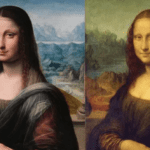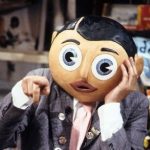 Mysteries
Mysteries  Mysteries
Mysteries  History
History 10 Surprising Stories About the Texas Rangers
 Humans
Humans 10 Philosophers Who Were Driven Mad by Their Own Theories
 Miscellaneous
Miscellaneous 10 Video-Game-Worthy Weapons and Armors from History
 Weird Stuff
Weird Stuff 10 Psychics Who Accurately Predicted Wartime Events
 The Arts
The Arts 10 Pieces of Art Inspired by a Broken Heart
 Health
Health 10 Science Fiction-Sounding New Medical Treatments
 History
History 10 Surprising Facts About the Father of Submarine Warfare
 Space
Space Ten Astonishing New Insights into Alien Worlds
 Weird Stuff
Weird Stuff 10 Bizarre Summer Solstice Rituals Still Practiced Today
 Mysteries
Mysteries Top 10 Haunting Facts About the Ghost Ship MV Alta
 History
History 10 Surprising Stories About the Texas Rangers
 Humans
Humans 10 Philosophers Who Were Driven Mad by Their Own Theories
Who's Behind Listverse?

Jamie Frater
Head Editor
Jamie founded Listverse due to an insatiable desire to share fascinating, obscure, and bizarre facts. He has been a guest speaker on numerous national radio and television stations and is a five time published author.
More About Us Miscellaneous
Miscellaneous 10 Video-Game-Worthy Weapons and Armors from History
 Weird Stuff
Weird Stuff 10 Psychics Who Accurately Predicted Wartime Events
 The Arts
The Arts 10 Pieces of Art Inspired by a Broken Heart
 Health
Health 10 Science Fiction-Sounding New Medical Treatments
 History
History 10 Surprising Facts About the Father of Submarine Warfare
 Space
Space Ten Astonishing New Insights into Alien Worlds
 Weird Stuff
Weird Stuff 10 Bizarre Summer Solstice Rituals Still Practiced Today
Ten Renowned Artists Who Were Unappreciated in Life
True artists don’t strive for fame. But even so, it’s vital for their work to be seen, read, or otherwise experienced by the public. The wider the audience, the stronger the artist’s influence on prevailing thoughts and opinions. And all artists—authors, painters, singers, and more—want their work seen, analyzed, and considered by society. The most influential artists can stir emotions, alter perspectives, and leave a lasting impact on the world. But what happens when that impact isn’t felt until long after the artist is gone?
It’s heartbreaking to think about, but many artists remain relatively unknown and anonymous until after their deaths. Their works take on greater significance only after they pass away and leave this mortal realm forever. Let’s look at ten world-famous artists who experienced exactly that situation. From authors to painters, here are ten underappreciated and impoverished artists who passed away before their work became famous. They never got the reputation and respect they’d worked for in life, but after death, it all came flooding in.
Related: 10 Rare Discoveries About Famous Artists And Their Art
10 Charles Bukowski
The author Charles Bukowski is a prime example of a literary figure whose genius went unnoticed during his lifetime. It was not until the waning years of his life and the decades following his death that Bukowski’s works attained the recognition and adulation they deserved. As an enigmatic artist, he was marked by a relentless pursuit of truth and unflinching portrayal of the human condition. That eventually led him to the realms of literary fame and worldwide respect. But it didn’t happen in his lifetime.
Born in 1920, Bukowski spent a significant portion of his life struggling in obscurity. He worked odd jobs while grappling with personal demons. His literary works were often characterized by gritty realism and unapologetic depictions of urban life. He loved to write about those on the margins of society. But despite his undeniable talent, Bukowski’s writing largely evaded mainstream recognition throughout his career.
It was not until the publication of his semi-autobiographical novel Post Office as a 51-year-old in 1971 that glimpses of literary success began to flicker on the horizon. But even after that, success was decades away, and he didn’t have decades to live. After working for most of his life at a post office in Los Angeles, Bukowski’s novels finally started getting some attention by the very end of his life. When he died of leukemia in 1994, he had only just started to “make it” in the literary world. After death, though, his reputation ballooned.
Today, three decades after his death, Bukowski is a literary icon. The spread of his work across the internet, the popularity of the Beat Generation, and a growing appreciation for unconventional voices in literature have all helped. And his raw portrayal of life’s hardships mingled with moments of profound beauty struck a chord with readers hungry for authenticity, too. It’s just a shame he never lived to see it for himself.[1]
9 Johann Sebastian Bach
It’s not often that you find an artist who completely excels in one talent but struggles mightily with another. But the renowned composer Johann Sebastian Bach faced this unique situation during his life. Despite his undeniable talent as a composer, his works went largely unnoticed while he was alive. However, Bach flourished as an organist at the same time. That was thanks to his musical upbringing in a German family and the wise guidance of his brother after the loss of their parents.
Bach held various positions as an organist during his days. He actively participated in the music scene in Europe, and regularly earned recognition for his exceptional performances. Ye, his compositions remained completely overshadowed. It wasn’t until the 19th century, when there was a renewed interest in the Baroque period, that Bach’s musical genius finally gained recognition.
During his career, he revolutionized Baroque music by infusing elements from Italy and France. His ideas elevated the German style to its peak. But the problem was that nobody knew it until after he died! But although it took time, Bach’s compositions now resonate worldwide. In that way, he has fulfilled every artist’s ultimate desire for their work to be appreciated by audiences across the globe. It just didn’t happen when he could experience it firsthand.[2]
8 Henry David Thoreau
Henry David Thoreau is now known as a profound thinker and influential figure. But it wasn’t always that way. He was largely ignored and misunderstood during his time. Despite this, his impact on individuals like Martin Luther King Jr. and Gandhi cannot be understated. But his thinking was outside-the-box during his life. And thus, Thoreau’s unconventional ideas and activism distanced him from mainstream society in the 19th century.
Of course, Thoreau found solace in nature. That became the central theme of his most widely-read book Walden. But life was challenging for the writer beyond that. Many of his works struggled to find publishers. He even funded the publication of some of them himself after being largely ignored by mainstream presses. And in doing that on his own, he often only sold a precious few copies at a time.
Amazingly, Thoreau passed away with just two professionally published works. And upon his death, they received little attention from the general public. He had remained essentially unknown in the literary world throughout his life. Yet today, he is regarded as a literary titan. His works, such as Civil Disobedience, continue to inspire great leaders. And his reflections on nature encourage artists and thinkers to reassess the significance of the natural world and the simple pleasures in life. It was a long road to the top for Thoreau, but he finally got there—more than a century after his death.[3]
7 Claude Monet
Claude Monet may have been the founder of French Impressionism, but he faced a tragic journey during his life. His groundbreaking works now adorn walls worldwide and are considered masterpieces. But at the time he painted in the late 19th and early 20th centuries, his works were criticized as formless and unfinished. Art buyers found them ugly. The art world mostly turned their back on the painter. And in short order, this condemnation plunged Monet and his family into years of dire poverty.
Monet’s unique form and technique captured the essence of atmospheric light in his landscape paintings. He believed that a landscape’s true nature is ever-changing, brought to life by the surrounding atmosphere. His masterpiece, “Impression, Sunrise,” gave birth to a new artistic movement. However, it took nearly a decade for his works to gain recognition and sell, beginning in the 1880s.
Yet, even amid his modest success, Monet faced accusations of commercialism from fellow painters. Of course, we now know he suffered partial blindness. That resulted in vibrant bursts of color devoid of distinct shapes in his later paintings. But throughout his life, things never came easy for the painter. While he’s massively popular today, he never knew it while creating art. Only at the very end of his life—and really, after his death—did Monet’s work take hold.[4]
6 Johannes Vermeer
Today, Johannes Vermeer is respected as one of the most famous artists to hail from Holland. But he had a long wait after death to become renowned for his creations. Born in 1632, little is known about his early life. After his father’s death, Vermeer took over the family art business. It’s unclear whether (or where) he apprenticed as an artist, but soon enough, he had gained knowledge via his experience in the art trade. Vermeer created his own paintings that focused on the provincial middle class instead of the church or nobility. In 1675, he borrowed money in Amsterdam to be a full-time artist. But his lack of sales left him unable to repay the loan, and it left his family in debt.
After Vermeer’s death, art historians overlooked his paintings for two centuries. Although some connoisseurs in the Netherlands appreciated his work, many of his pieces were mistakenly attributed to more famous artists. But after two hundred years of relative anonymity, museum director Gustav Waagen saw The Art of Painting in the Czernin gallery. He fell in love with it and pushed for Vermeer to finally receive recognition.
Initially attributed to Pieter de Hoch, the painting prompted further research and the creation of a catalog of Vermeer’s works. Now, art lovers and historians alike know quite a bit more about the artist’s work—even if his life remains a mystery. His art continues to inspire other painters today, too. And yet none of this was feasible when Vermeer died in the late 17th century.[5]
5 Emily Dickinson
Emily Dickinson suffered the cruel fate of time’s backwardness. Despite creating numerous poems, only a handful of her nearly 1,800 compositions were published while she lived. Moreover, these published poems underwent significant alterations to conform to the conventional rules of the era. It was only after death that her true intellect and talent were fully understood.
Characterized as an eccentric, Dickinson deliberately kept her extensive collection of poems away from the public eye until her passing. Her seclusion was legendary. She seldom received visitors or even ventured beyond her bedroom. She maintained friendships primarily through written correspondence. And yet her undeniable talent and unique style cannot be overlooked.
Dickinson’s poems featured concise lines, which was rare at the time. They also often employ slant rhymes, unconventional capitalization, and punctuation. In her letters to friends, she frequently explored themes of death and immortality. Those then seamlessly translated into her poetry. Then, after Dickinson passed away in 1886, her younger sister Lavinia stumbled upon her hidden trove of poems. Recognizing what was there, she finally unveiled the remarkable collection to the world.
The poet’s first collection was published four years after her death, in 1890. Dickinson was lambasted by critics at the time, but patience won out. In the ensuing decades, she came to be regarded as one of the greatest-ever American poets. Even today, her legacy carries on strongly as a master of the genre. And yet she never lived to see any of it—and might well have been horrified by it had she done so.[6]
4 Edgar Allan Poe
Edgar Allan Poe is now known for his dark tales and poetry. Unsurprisingly, he was deeply influenced by his troubled life. Born in 1809, his father abandoned the family and his mother succumbed to tuberculosis. Tragedy struck again with his brother’s death not long after that. It ended up being what spurred Poe’s writing career. Yet surviving as a writer was as tough then as it is now. And for most of his life, Poe never found financial success or worldwide acclaim based on the things he wrote.
The pain in Poe’s life extended to his marriage with his 13-year-old cousin, Virginia. She died from tuberculosis only four years after they were wed. Her loss deeply affected him. It can be seen now in his renowned poem “The Raven,” where a talking raven visits a distraught lover before descending into madness. But despite the poem’s international success nowadays, Poe received a mere $9 for its publication.
Poe’s struggles persisted until his own untimely demise. His alcoholism and personal issues became evident as his adult life carried forth. His demons led to unsuccessful attempts at starting a journal. And with his career on the outs, it all ended for him in a sad way. Tragically, he was found unconscious in a Baltimore gutter in 1849. He was quickly pronounced dead due to unknown causes. None of the respect he’s earned in the two centuries since ever came to him in life.[7]
3 Jeff Buckley
Few modern musicians have achieved posthumous fame on the scale of Jeff Buckley. Born in 1966 to the legendary folk singer Tim Buckley, Jeff struggled to carve out his own identity as a musician. Despite his undeniable talent, his star failed to ascend during his short life. It was only after his untimely death by drowning in the Mississippi River that the world truly embraced his ethereal voice and haunting songs.
Buckley’s breakthrough came with the release of his debut album Grace in 1994. But by then, he’d already been dead for three years. The album showcased his signature blend of folk, rock, and soul. It quickly struck a chord with listeners who were captivated by his raw emotion and soaring vocal range. From the tender melancholy of “Lover, You Should’ve Come Over” to the spine-tingling rendition of Leonard Cohen’s “Hallelujah,” Buckley’s songs resonated intensely.
Despite his lack of commercial success during his lifetime, Buckley’s posthumous rise to fame was swift and far-reaching. Grace garnered critical acclaim. It also earned the late singer a devoted following that grew with each passing year. Today, his interrupted body of work has fully solidified his status as a cult icon. In that way, Jeff Buckley’s tragic tale serves as a poignant reminder of the bittersweet nature of artistic success. The world discovered a true musical genius only in the wake of his untimely demise.[8]
2 Herman Melville
Herman Melville was the (now world-famous) author of a certain beloved 20th-century book. But in his lifetime, he faced countless failures following the initial success of his debut work. Surprisingly, his first book, Typee, garnered some attention from his peers. Inspired by his experiences in the Polynesian Islands, other writers liked that one during his life. But fame and fortune mostly eluded the author. And his best (and, today, best-known) works were sadly neglected and forgotten while he was still alive.
Of course, Moby Dick was Melville’s masterpiece. But it was actually out of print when he passed away. Plus, his other novels received mediocre reviews and failed to provide him with any sort of financial stability. Despite these hardships, Melville resorted to the lecture circuit at the time. He also persisted in his work through producing considerable amounts of poetry.
Tragically, he died abruptly in his New York City home in 1891 before ever having tasted the literary acclaim that would come posthumously. Thankfully for us, though, the literary world enjoyed a major resurgence of his works through the 20th century. Today, the name of Herman Melville will endure eternally.[9]
1 Domenikos Theotokopoulos
The artist Domenikos Theotokopoulos is today more commonly known as El Greco. But during his lifetime in the 16th century, he may as well have been anonymous. El Greco hailed from Crete and earned his nickname after painting icons in Italy and Spain. In Venice, he absorbed the techniques of renowned artists like Titian and Tintoretto. He adopted their vibrant colors and loose brushwork. He was also heavily influenced by Michelangelo, who favored a subjective approach over realism. But he couldn’t find his own footing in the industry until after death.
Despite acknowledging Michelangelo’s talent, El Greco controversially remarked that the renowned Italian artist lacked painting skills. This view caused difficulties for him in Rome forever after. There, he struggled to secure consistent work. Forced to relocate, El Greco settled in Toledo, Spain. In that city, he produced his most famous works. However, even in Spain, his success came with challenges.
Although he received several commissions, such as the Allegory of the Holy League and the Martyrdom of St. Maurice, King Philip disliked his creations. The king relegated the St. Maurice altarpiece to the chapter-house instead of the intended chapel. After that, he refused to offer further commissions. Scholars speculate Philip objected to El Greco’s inclusion of living individuals in religious scenes. Others wonder if it was because his works deviated from the Counter-Reformation’s emphasis on content over style.
Critics scorned El Greco after his death too. Amazingly, it was not until the 18th century that his work garnered the recognition it deserved. Despite not dying destitute, his legacy faced immense disdain. It was only through a later reevaluation of his art that El Greco finally received the credit he was due. Of course, by then, it was several centuries too late.[10]








